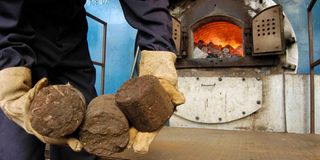Unsung heroes powering Kenya’s Green future

An attendant feeds briquettes into a boiler.
What you need to know:
- The search for clean, affordable and scalable energy solutions has become more urgent than ever.
- Hidden behind the noise of policy forums and summit speeches, a quiet revolution is unfolding.
As Kenya continues to battle rising energy costs, unreliable power supply and the growing threat of climate change, one question echoes through boardrooms, factories and households: how do we fuel development without compromising our environment?
The search for clean, affordable and scalable energy solutions has become more urgent than ever. Hidden behind the noise of policy forums and summit speeches, a quiet revolution is unfolding.
What began for me as a passing glance at a trending hashtag—#Go Lean Go Green—for a university essay quickly turned into an eye-opening discovery; a uniquely Kenyan model of renewable energy that is not only reducing emissions but reshaping industries, livelihoods and lives.
Waste-to-energy concept
Rather than relying on fossil fuels or burdening factories with the cost of green technology, a bold solution has emerged—building and operating biomass boilers at industrial sites. The factories don’t buy the equipment. They don’t worry about maintenance. They simply purchase steam, cleanly and efficiently generated using agricultural waste.
The numbers speak volumes: more than 350,000 tonnes of carbon dioxide emissions avoided; over $50 million saved in foreign exchange by replacing imported fossil fuels with locally available biomass.
It’s a system built on simplicity and innovation. Macadamia shells, maize cobs, coffee husks, sawdust, bagasse and ply waste are now powering Kenya’s manufacturing sector. This waste-to-energy concept doesn’t just cut carbon emissions, it injects life into rural economies, creating jobs, stimulating transport networks and giving value to what was once discarded. With hundreds of biomass suppliers, transporters and full-time staff who are part of this green ecosystem, it’s a web of local enterprise woven around sustainability.
Behind the industrial steam and carbon offsets lies a deeper mission. Without fanfare, the initiative is fully funding the education of thousands of needy students. No public relations campaigns, no red-carpet galas, just a steadfast commitment to long-term transformation of energy systems, lives and futures.
Empowerment of communities
These efforts continue largely under the radar. While much of the national conversation revolves around electricity tariffs and fuel subsidies, this homegrown renewable solution is quietly proving that green transition is already underway.
This is not just a technological achievement; it reminds us that Kenyan ingenuity, when aligned with purpose and sustainability, can solve some of the most pressing challenges of our time. It invites us to rethink what power really means, not just in kilowatts, but in the empowerment of communities and protection of our environment. As the world races to reduce global emissions, Kenya’s contribution may seem modest. But stories like these show that local action can have global resonance.
Let’s celebrate the industries powered by maize cobs and coffee husks. Let’s recognise the unsung engineers, suppliers and transporters who are building a greener tomorrow. Let’s ensure that these heroes are not left in the shadows.

